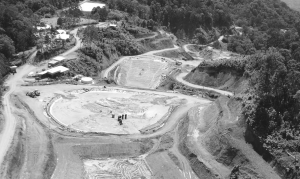Vancouver — At the producing Sinivit gold mine in Papua New Guinea, expansion drilling is returning high-grade gold oxide at surface and well-mineralized sulphide from just below for New Guinea Gold (NGG-V, NGUGF-o).
New Guinea started production at Sinivit one year ago, using mobile crushing equipment and a small leach vat to extract gold from oxidized, near-surface rock. Sinivit’s oxide mineralization is contained in three zones: the adjacent South and Central oxide zones and the 300-metre distant North oxide zone.
The company’s efforts to expand each oxide deposit are being rewarded. In the Central zone, hole 70 returned 6 metres of 21.5 grams gold per tonne within a 20-metre interval averaging 8 grams gold, starting 4 metres below surface. Hole 69 cut 10 metres of 5.9 grams gold and hole 71 hit 16 metres grading 3.1 grams gold.
In the south zone, hole 118 returned 20 metres essentially from surface grading 17.2 grams gold.
And up in the North zone, hole 51 cut 12 metres grading 16.9 grams gold, hole 53 hit 24 metres of 10.5 grams gold, and hole 37 returned 31.8 grams gold over 4 metres.
The slew of new results, including 245 short reverse-circulation holes, is sure to grow the Sinivit oxide resource. However, since the company expects to continue drilling apace, it doesn’t plan to review the resource calculation until “well into 2009,” according to chairman and CEO Bob McNeil.
The last resource estimate, from mid-2006, calculated Sinivit’s resources as 713,000 indicated tonnes grading 5.7 grams gold and 340,000 inferred tonnes grading 3.2 grams gold.
The company is also probing the property’s deeper sulphide mineralization, which it hopes to start mining in three years. Sulphide mineralization contains gold, silver, copper and tellurium. However, in the first round of assays, drill core was tested only for gold and copper; high-grade copper intervals have been resubmitted for silver and tellurium analysis.
Copper-gold intersections from just below the proposed limits of the oxide-gold mining operation in the South and Central zones returned prospective results. In the South zone, hole 189 returned 20 metres of 25.7 grams gold and 2.19% copper from 8 metres depth, hole 193 cut 10 metres of 10.1 grams gold and 0.94% copper from 4 metres down-hole, and hole 188 hit 10 metres grading 4.4 grams gold and 2.18% copper from 20 metres depth. In the Central zone, hole 2 returned 4 metres grading 17.5 grams gold and 3.21% copper from 22 metres depth and hole 5 hit 2 metres averaging 10.5 grams gold and 2.35% copper.
In addition, previous diamond drilling indicated that similar sulphide mineralization extends at depth along the 300 metres between the Central and Northern zones. McNeil says these initial sulphide results are “very encouraging” and the company will continue to test the extent of Sinivit’s sulphide potential.
Currently, 55,000 tonnes of ore is crushed and sitting in leach vats at Sinivit. In July, the cone crusher broke down for a sustained period, setting gold production back by roughly one month.
New Guinea also ran into problems with the new, large leach vats installed following commissioning. The initial vats at Sinivit were relatively shallow (3 to 4 metres deep) and allowed for 80% recovery in two months. The first major production vat was considerably deeper (10 metres); the company found the resulting compaction of the crushed ore reduced permeability, substantially reducing the leaching rate. Leaching vat contents is now expected to take six months.
New Guinea plans to restrict the depth of leach vats to less than five metres, which means the company will have to install more vats than originally planned to maintain capacity.
Despite the cone crusher breakdown and the leach vat problem, Sinivit produced 1,730 oz. gold and 242 oz. silver in the second quarter of 2008. The company expects third-quarter production to come in at 1,900 oz. gold and predicts 5,500 oz. gold in the fourth quarter.
In September, New Guinea also began a preliminary assessment of its flagship project, Imwauna. A recent resource estimate pegged Imwauna’s inferred resources at 1.8 million tonnes grading 12.2 grams gold and 20 grams silver per tonne. The resource starts at surface
and extends to depths between 50 and 150 metres. Several high-grade zones have been delineated. The deposit remains open in most directions and two drills are turning on-site.
Providing the preliminary assessment returns a positive result, New Guinea hopes to start open-pit mining at Imwauna in 2010, at a rate of 70,000 to 100,000 oz. gold annually.
On news of the latest Sinivit results, New Guinea Gold lost 2 to close at 30. The company has a 52- week trading range of 26.5-63 and has 156 million shares issued.


Be the first to comment on "New Guinea Gold tracks gold-rich oxide at Sinivit"